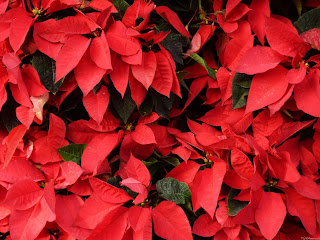The Creation of my backyard habitat for wildlife and our enjoyment and how it has grown and changed since 2004.
Wednesday, January 9, 2013
How to Keep Christmas Flowers Growing Year-Round
Part 1
Poinsettias, Paperwhites, Amaryllis & even Christmas Cactus are a beautiful addition to Christmas decorations. Sadly, they are treated as cut or silk flowers by many people and tossed out when the ornaments are put away at the end of the holiday season. However, this doesn't have to happen. With forethought in selection, proper care during the holiday season and afterward, all these plants can be successfully planted and grown for long-term enjoyment. This post I'll tell you how to preserve your Poinsettia. Check soon for information on how to keep the other Christmas flowers growing.
Poinsettias- during the holiday season:
Start by buying a healthy plant:
A healthy poinsettia makes replanting easier. A poinsettia with dense foliage all the way to the soil is a sign of a healthy plant. Buy a poinsettia with stiff stems and does not have any wilting, breaking or drooping. Avoid plants that come in sleeves made of plastic, paper or mesh or ones that are crowded on the store shelves; this reduces air flow, which a poinsettia needs. Check the soil and do not buy a plant whose soil is waterlogged, as this can cause root rot. Despite the fact that poinsettias are holiday plants, they originate in Mexico. Protect them from cold winds or temperatures below 50 degrees; cover them with a large, roomy shopping bag when transporting them from the store.
During the Holidays:
1.Do not place it in direct sunlight or block the sunlight with curtains or shades. Keep the temperature in the room between 68 and 70 degrees and do not put the plant near drafty doors, heating and air conditioning ducts or fireplaces. Set the poinsettia in the sink or tub when watering so the water will drain completely; never leave standing water in the poinsettia’s container or saucer.
2.Remove the wilted bracts and leaves from the poinsettia. Continue to monitor the light, heat and water for the plant. Cut the poinsettia down to 8 inches tall in late March or early April and apply a balanced all-purpose fertilizer. You should see new growth beginning in May.
When the weather is warmer:
3.Move the poinsettias outdoors when all danger of frost has passed and the night temperatures are above 50 degrees. Place them in indirect light. After late May, move it to a larger pot that has a good mix of peat moss or organic matter in the soil. Continue proper watering and apply a light balanced fertilizer every 2 to 3 weeks. Prune the poinsettia, beginning in late June or early July, to keep it compact; stop pruning at the end of August.
In the Fall
4.Bring the poinsettia back inside when temperatures drop below 50 degrees. Continue to monitor the plants' water and light exposure; extended exposure to even a table lamp could delay the blooming. Make sure the temperature around the poinsettias remains 60 to 70 degrees; anything outside of this can affect the bloom time. It will begin to grow leaves and set buds in the fall and bloom during November and December.
5.Keep the poinsettia in 14 continuous hours of darkness each night after late September. Move it to a totally dark room--such as a closet--or cover it with a box that is large enough so as to not crowd the plant. Continue the regular watering and fertilizing during the holiday season.
If you happen to live in a tropical climate: you can plant your Poinsettia outdoors.
1.Keep the plant dry throughout the winter months, watering sparingly. Do not fertilize the plant at this time.
2.When the weather warms up to a steady 55 to 60 degrees Fahrenheit, cut off any faded leaves, leaving behind spiky stems.
Place the potted poinsettia outdoors so that it can get used to the outdoor weather. Leave it outdoors in a pot for two to three weeks, as this allows it to acclimatize to both the light and the temperature.
4.Select a site where the poinsettia will receive full sun for most of the day but no light at all during the night. Avoid areas that are illuminated by street lights.
5.Dig a hole in the garden bed for the poinsettia that allows it to sit at the same level in the ground as it did in the pot.
Place the poinsettia into the ground and firm the soil around its base.
7.Apply a 2-inch-thick layer of mulch around the base of the poinsettia to help it retain water.
8.Water thoroughly.
9.Fertilize monthly with an 18-16-12 fertilizer, which contains 18 percent nitrogen, 16 percent phosphorus and 12 percent potassium. Use 2 lbs. per 100 square feet.
When I lived in Florida I was able to keep a flowerbed of poinsettia's alive for several years in a protected spot in my yard.
Labels:
Christmas Flowers,
Poinsettias
Subscribe to:
Post Comments (Atom)

How to take plant care during holidays? Choose the pots; make sure there are holes in the bottom of your container to allow water to flow out freely, etc.
ReplyDelete